Taiwan's ITRI Unveils Brilliant LED Lighting Technologies
2011/05/24 | By Ken LiuOne magnetic-related technology is being developed to raise LED output
Over the past year, Taiwan's government-backed Industrial Technology Research Institute (ITRI) has introduced several LED (light emitting diode) technologies that can help to enhance local LED-lighting manufacturers' cost efficiency, product performance, durability, innovation and user friendliness.
One notable technology is “flexible package,” which has been achieved by the Electronics and Optoelectronics Research Laboratories (EORL) via depositing LED chips on copper film electroplated on flexible polyimide (PI) board. The lab calls the process “chip-in-flextech” packaging and officially “FlexLite.” “We're the world's first to introduce flexible LED technology for general lighting though Japan has built the technology into direction boards,” says C.Y, Huang, a project deputy manager at the Opto-Electronics Device Fabrication Department of the EORL.
Flexible LED lighting is innovative but making flexible printed circuit board is a relatively mature technology. “We simply integrate flexible board technology with existing LED materials,” says Huang.
Huang's department exhibited a prototype of flexible electronics technology at a workshop in Taipei last year, one about 2,000 square nits (around 5.2 square inches) that carried 200 0.6W LED chips. The unique packaging technology enabled the LED module to be only 350 micron thick or around one-sixth that of SMD (surface mount device) package.
Aggressive Goal
Working on the LED module carries an aggressive goal: compete against organic LED (OLED) for a dominant share of the global market for indoor flexible-panel lighting. “Luminous efficacy of OLEDs is inversely proportional to its thickness, but not so with flexible LEDs,” says Huang, who remains confident of the latter due to price advantage, being only one-twentieth that of OLED panels. “An A4-sized LED panel costs a net US$66 or so,” he says.
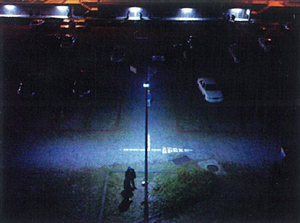
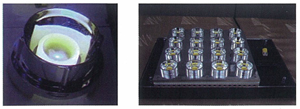
Once produced in volume, the LED panels will be shipped in rolls, instead of individual package devices, helping to further cut cost ant enhance affordability. “With commercial production expected soon, we believe it's realistic to cut LED lighting price to US$2.5 per-kilo-lumen by 2015 from the current US$25,” Huang predicts.
The flexible module achieves relatively commendable luminosity—50-60 lumen-per- watt—and color temperature of warm white 3800K to cold white 11,000K at 85-and-above CRI. The overall effect is 95% perfect, says Huang.
Available with AC or DC LED chip, the EORL has developed a commercial AC LED panel module for indoor lighting. The 130W 66cm x 66cm module is about 10 mm thick, has sub-5mm radius, above-4000 lumen output and is radio controlled to change color temperature and luminous definition.
Such LED panel lighting will likely replace E27s as mainstream and are suitable for overhauling indoor lighting but not retrofits, for being without E26/27 screw base, says Huang.
Ultimate Goal
The ultimate goal in illumination is to distribute light precisely where intended without scattering. The EORL's unique LED lens methodology, dubbed “variable light pattern” that seems to tap optical characteristics, whereby the lab uses “lens bars,” each of which has integrated arrayed LED packages to control light distribution, says C.C. Lin, a project manager.
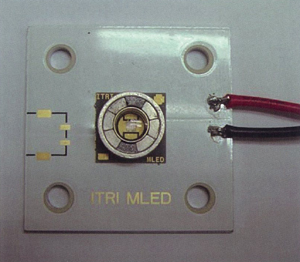
Arranging the lens bars asymmetrically or symmetrically on a module achieves the goal of precision light distribution. “Streetlights are equipped with ‘+' arrays to distribute light across intersections; while the lens bars can be arrayed in other geometric patterns to achieve other light patterns, says Lin. Diffusion angles are also computer simulated to ensure precise light distribution before production.
Shedding light on an extra benefit of precision distribution, Lin says that studies have shown that nocturnal, scattered light may cause poor harvest of some crops as rice. “Rice has been frequently found with empty husks for being overexposed to artificial nocturnal light that forces growth during unnatural hours.”
Lin's organization has also achieved plug-in operation by integrating current-bridge ICs or drivers into the lens bar with high-voltage (HV) LED technology, enabling the lighting fixture to be simply inserted into AC outlets. “Such technology eliminates the need of bulky electrolysis capacitance box as transformers that are usually seen in DC LED streetlights.”
Lightweight and modularization enable easier maintenance of lens-bar streetlights, whose light patterns can also be conveniently adjusted. Burnt modules are simply taken down and replaced without having to take down entire lighting units as typically needed with electrolysis-capacitance counterparts,” Lin stresses.
A typical 100W, 220V lens-bar streetlight with 144 individual packages is rated at 5500-6000 lumens.
Field tests of lens-bar streetlights show triple to quadruple the life cycles of electrolysis-capacitance counterparts due to streamlined design. “Normally the capacitance units last 8,000-9,000 hours but shorter under inclement weather,” Lin says.
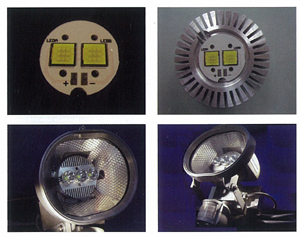
EORL's “ring remote phosphor LED packaging technology” is another effective way to boost LED durability and luminous efficacy. Instead of applying yellow phosphor powder directly on blue chips to generate white light—the most common formula—the technology plasters phosphor on a ring surrounding the chip. Light is fully refracted to the phosphor to enable the package to achieve 20% higher luminosity than traditional packages,” says Hong-weng Chang, an EORL manager.
This reflector design eliminates the need of diffusion panels and prime lens, making the package side-emitting and simplifying secondary-lens design.
Phosphor longevity is assured by optimizing the gap between chip and phosphor. “Heat from the chip is gap-insulated from the phosphor to minimize early fatigue of the phosphor,” Chang says, adding that less heat also ensures improved light uniformity.
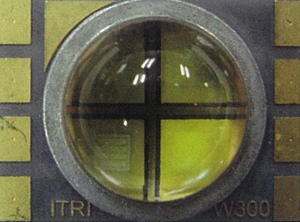
Chang concedes that the EORL is hardly the first to develop the “remote phosphor” technology, but is the originator of using the ring.
Such packaging technology is ideal for general illumination, automotive lighting, reading and projection lamps.
Magnetism
Chang is also promoting a technology associated with magnetic field, which can help raise LED output by 10%.
“Light output increases because magnetic resistance improves density-uniformity of current into LEDs, with the magnetic-freeze-out effectively enhancing the combination of internal quantum effect (IQE) and carriers,” Chang explains.

LEDs can have magnetic materials attached to create magnetic effect, a technique the EORL is originating to achieve higher LED output, according to Chang.
“Silicon optics integration (SOI)” packaging and “robust color tunable projection light module” are other projects under way at the EORL. SOI involves bundling control circuit, electrical resistance circuit and other circuits with LED chips onto silicon-based substrate and equipping such package with silicon micro reflector. “Silicon substrate is an effective heat conductor while silicon reflector improves light extraction efficiency,” Chang says.
SOI packaging is specifically developed for LED lamps rated above 10W, while a typical 10W SOI package produces 70 lumen-per-watt at 3C-per-watt in thermal resistance.
The projection light module has tunable color temperature ranging between 2800K and 7000K due to red, blue, green, and white light packages. Nonconductive coolant is integrated for heat dissipation to improve resistance to lightning and moisture.
Glare Control
LED manufacturers have been trying to strike an optimal balance between light output and glare, an issue the ITRI's Mechanical and Systems Research Laboratories (MSRL) recently addressed with an efficient process called “glare-free LED lighting film technology.”
Field tests show such film to have excellent luminosity-to-glare characteristics: 88% light output versus 98% luminous evenness. “The effect is the effective transformation of dot-matrix light distribution to linear-light or area-light distribution,” says Frank Lin, an MSRL project manager.
Lin says the key to achieving such characteristics is the “micro-grade structure” rolled onto the film surface. The roller is plated with a copper layer 200-300 micron thick and a diamond-tipped cutter is used to render irregular micro nubs, which is used as mold to press patterns on a plastic film on a flexible PET substrate, which is then exposed to UV to solidify the semi-melted pattern, according to Lin.
“Lab production of the film is eight meters per minute, but for commercial production, we have 10-meter-per-minute process to license the technology,” Lin says.
The film is being developed for LED light tubes like T5 and T8 as well as LED signages, and Lin says the lab is developing such film for LED light bulbs to soon introduce the product, says Lin.
Initially the diffusing film was intended for flat-panel displays to “smooth” picture quality, but around a year ago Lin's laboratory began tweaking the technology for LED lighting.
Low-temp LED
The MSRL has also recently introduced “low-temperature LED die-bonding technology” and “three-dimension LED packaging module.”
The low-temperature technology significantly lowers defect-free rate of LED die bonding, crucial in packaging as the bonding temperature is sub-100C or only around one-third the 330C required by the popular eutectic die bonding methodology. “The low-temperature technology uses low-watt laser to minimize damaging devices as LED chip in bonding, enhancing reliability of LED packages,” says Johnny Lin.
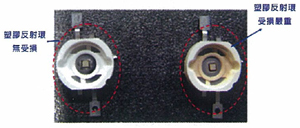
Despite the low temperature, the bond is durable, with ultimate tensile strength (MPa) rated at 30 and joints able to withstand at least 30C. In addition, the bonded layer achieves satisfactory thermal conductivity of 50W/mK, with the die bonding technology being efficient at five-chips per second.
The 3D packaging module can project over 90% of light as intended without needing secondary lens design. “Computer analysis enables us to install LED packages on light modules at various angles to achieve optimal light distribution,” says Johnny Lin. A typical module has 25 packages in 5x5 array that suit streetlighting, auto lighting, indoor and outdoor lighting.
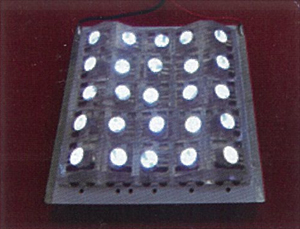
Side-by-side field testing by the lab, with thermographic imaging of streetlights, shows the 3D module streetlights emitting linear patterns versus round patterns from traditional LED streetlights. The linear pattern is “seamless” while the round distribution has dark gaps. “Driving confidence is vastly enhanced with even, continual lighting,” Lin says.
An added advantage is that the 3D modules do not need domed lens, hence cutting manufacturing cost, as well as overall thickness of the housing to only about three centimeters, coupled with faster production.




